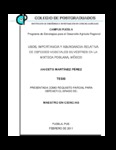| dc.description.abstract | Las especies vegetales silvestres de la Mixteca Poblana tienen importancia socioeconómica y cultural para los habitantes de la región; son fuente de productos alimenticios, medicinales, combustibles y materiales para construcción. Sin embargo, se ha observado que la destrucción y degradación de la cobertura vegetal ha disminuido la oferta natural de estas especies, al punto de poner en riesgo de extinción a estos recursos fitogenéticos indispensables para las comunidades de la región. No obstante lo anterior, los estudios relacionados con el uso, importancia y abundancia de las especies silvestres útiles de esta área, son escasos. Por ello, el objetivo de este trabajo fue contribuir a la elaboración de un inventario de especies silvestres útiles de las áreas cerriles del municipio de Chietla, Puebla, y estimar su importancia y abundancia para establecer prioridades de manejo. Se realizaron entrevistas a 14 informantes clave y se colectaron especímenes para muestras de herbario; se evaluaron 13 variables socioeconómicas y ecológicas en 47 especies, y se aplicó el método de transectos y distancias en dos comunidades (Buenavista y Huajotitlán) para estimar la abundancia de las especies vegetales más importantes. Los análisis descriptivo y factorial mostraron que en Buenavista hubo127 especies, con nueve tipos de uso; dos de esas especies tuvieron condiciones aptas para su manejo inmediato y tres requieren reforestación. En Huajotitlán se registraron 142 especies, con nueve tipos de uso, tres de esas especies cuentan con condiciones aptas para manejo y cinco tienen necesidad de reforestación. También se realizó un análisis de componentes principales, observándose que de las 47 especies más apreciadas en ambas comunidades, sólo cuatro sobresalieron por la posibilidad de extracción, por su potencial de comercialización y por su abundancia. Sin embargo, las poblaciones de estas cuatro especies de gran valor local, podrían desaparecer de esta región en pocos años si no se les brinda un manejo adecuado. _______________ USES, RELEVANCE, AND RELATIVE ABUNDANCE OF WILD PLANT SPECIES AT LA MIXTECA POBLANA, MEXICO. ABSTRACT: Wild plant species from La Mixteca Poblana have socioeconomical and cultural relevance for people living in that region; those plants are a source of food, medicinal, fuel, and construction products. However, destruction and degradation of the natural vegetation have reduced the natural offer of those species at such point that some of those plant genetic resources, relevant for the communities in the region, are at an extinction risk. Moreover, there are few studies related with the use, relevance, and richness of the wild useful species at La Mixteca. The goal of this research was to contribute to the preparation of an inventory of the useful and wild plant species from the hills of the municipality of Chietla, Puebla, Mexico, and to estimate their relevance and abundance to propose management priorities. Fourteen interviews with key informants were conducted, specimens were collected for herbarium vouchers; thirteen socioeconomical and ecological variables were tested on 47 plant species; to estimate the abundance of the most important species, the transect and distances method was applied at two localities (Buenavista and Huajotitlán). Descriptive and factorial analyses showed that at Buenavista, 127 plant species were recorded, with nine use categories; two of those species were identified as suitable for immediate management strategies, and three of them require a reforestation program. 142 species were registered at Huajotitlán, with nine use categories; three of those species were considered as suitable for immediate management strategies and five of them require a reforestation strategy. A principal components analysis was done; out of the 47 most important plant species valued by the people of both communities, only four were relevant for their possibilities of extraction, trading potential, and abundance. However, populations of those four species with high local value could dissapear from the region in a few years if suitable management strategies are not implemented. | es |

